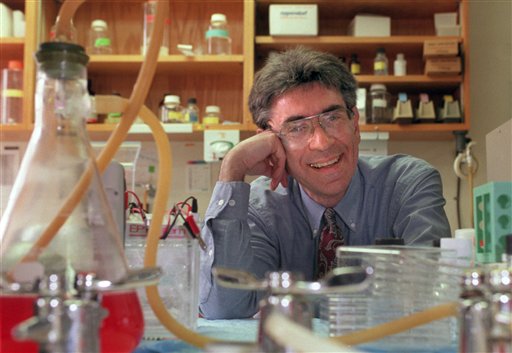(AP) 2 US scientists win Nobel chemistry prize
By KARL RITTER and LOUISE NORDSTROM
Associated Press
STOCKHOLM
Two American researchers won the Nobel Prize in chemistry Wednesday for studies of protein receptors that let body cells sense and respond to outside signals like danger or the flavor of food. Such studies are key for developing better drugs.
The Royal Swedish Academy of Sciences said Robert Lefkowitz and Brian Kobilka had made groundbreaking discoveries, mainly in the 1980s, on an important family of receptors, known as G-protein-coupled receptors.
About half of all medications act on these receptors, including beta blockers and antihistamines, so learning about them will help scientists to come up with better drugs.
The human body has about 1,000 kinds of such receptors, structures on the surface of cells, which let the body respond to a wide variety of chemical signals, like adrenaline. Some receptors are in the nose, tongue and eyes, and let us sense smells, tastes and light.
Lefkowitz, 69, is an investigator at the Howard Hughes Medical Institute and professor at Duke University Medical Center in Durham, North Carolina.
Kobilka, 57, worked for Lefkowitz at Duke before transferring to Stanford University School of Medicine in California, where he is now a professor.
Lefkowitz said he was fast asleep when the Nobel committee called, but he didn’t hear it because he was wearing ear plugs. So his wife picked up the phone.
He said he didn’t have an “inkling” that he was being considered for the Nobel Prize.
Kobilka said he found out around 2:30 a.m., after the Nobel committee called his home twice. He said he didn’t get to the phone the first time, but that when he picked up the second time, he spoke to five members of the committee.
He said he would put his half of the 8 million kronor ($1.2 million) award toward retirement or “pass it on to my kids.”
The academy said it was long a mystery how cells interact with their environment and adapt to new situations, such as when they react to adrenaline by increasing blood pressure and making the heart beat faster.
Scientists suspected that cell surfaces had some type of receptor for hormones.
Using radioactivity, Lefkowitz managed to unveil receptors including the receptor for adrenaline, and started to understand how it works.
Kobilka and his team realized that there is a whole family of receptors that look alike _ a family that is now called G-protein-coupled receptors.
In 2011, Kobilka achieved another breakthrough when his team captured an image of the receptor for adrenaline at the moment when it is activated by a hormone and sends a signal into the cell. The academy called the image “a molecular masterpiece.”
The award is “fantastic recognition for helping us further understand the intricate details of biochemical systems in our bodies,” said Bassam Z. Shakhashiri, president of the American Chemical Society.
Mark Downs, chief executive of Britain’s Society of Biology, said the critical role receptors play is now taking for granted.
The U.S. has dominated the Nobel chemistry prize in recent years, with American scientists being included among the winners of 17 of the past 20 awards.
This year’s Nobel announcements started Monday with the medicine prize going to stem cell pioneers John Gurdon of Britain and Japan’s Shinya Yamanaka. Frenchman Serge Haroche and American David Wineland won the physics prize Tuesday for work on quantum particles.
The Nobel Prizes were established in the will of 19th-century Swedish industrialist Alfred Nobel, the inventor of dynamite. The awards are always handed out on Dec. 10, the anniversary of Nobel’s death in 1896.
___
AP Science Writer Malcolm Ritter in New York and AP writers Amanda Kwan in Phoenix, Jack Jones in Columbia, South Carolina, and Danica Kirka in London contributed to this report.

COMMENTS
Please let us know if you're having issues with commenting.